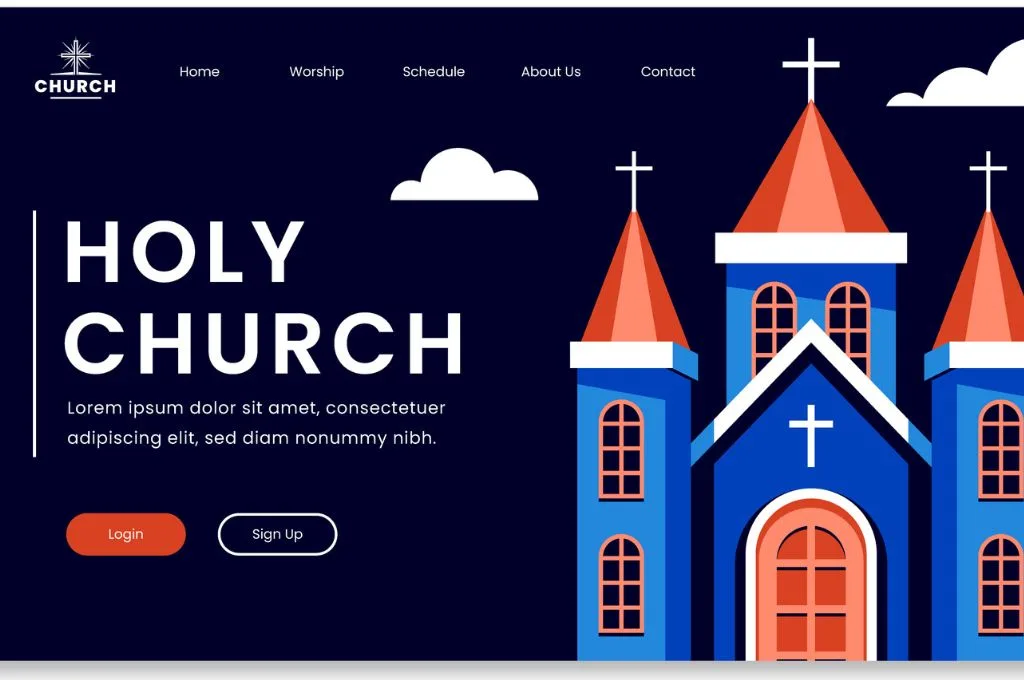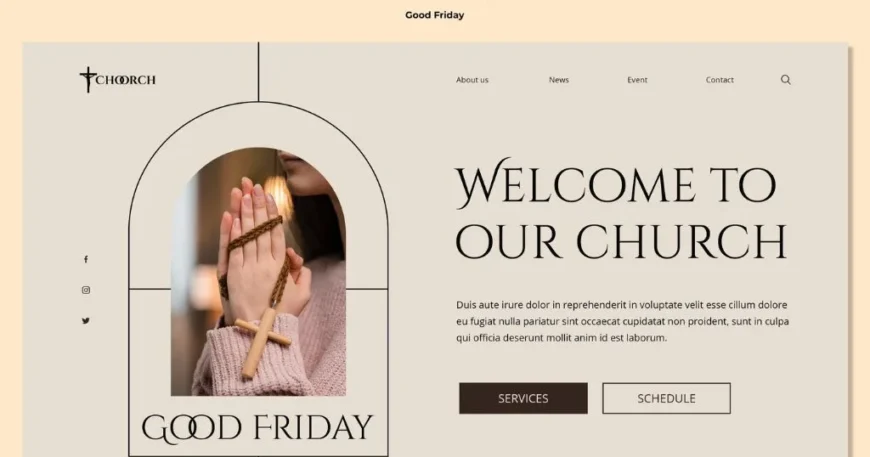In today’s digital age, having a captivating online presence for churches to reach and engage people is essential with their communities. An attractive website acts as more than just a virtual hub for congregation members it also acts as a powerful tool for attracting newcomers. With the popularity and versatility of WordPress, building a stunning church website has never been more accessible. This thorough tutorial will assist you in developing a dynamic and impactful church website using WordPress.
Getting Started: Setting Up Your WordPress Site
The first step in building your church website with WordPress is to set up your hosting and domain. Choose a reliable hosting provider with WordPress installation, such as Bluehost or SiteGround. Once you’ve signed up for hosting, you can install WordPress with just a few clicks. After installing WordPress, select a theme that aligns with your church’s brand and mission. Plenty of free and premium themes are available, so take your time to find the perfect one.
Crafting Compelling Content: Highlighting Your Church’s Mission and Values
When it comes to developing content, an engaging church website. Start by **bolding** your **keyword**, highlighting your church’s mission, values, and beliefs. Use emotional words like “inspiring,” “uplifting,” and “community-driven” to evoke a sense of connection and belonging. Incorporate powerful imagery and videos that showcase your church’s activities, events, and ministries. Remember to keep your content informative, authentic, and relevant to your target audience.
Creating a User-Friendly Navigation: Making Information Accessible
A user-friendly navigation menu is essential for guiding visitors through your church website. Organize your pages logically with About Us, Ministries, Events, Sermons, and Contact sections. Use clear and descriptive labels for each menu item, making it easy for users to find the information they want. Incorporate dropdown menus or sidebar widgets for additional navigation options, such as specific ministry pages or upcoming events.
Engaging with Your Community: Integrating Social Media and Online Forums
Harness the power of social media to foster community engagement and connection. Integrate social media plugins into your WordPress site, enabling users to quickly distribute your work on platforms like Facebook, Twitter, and Instagram. Consider creating an online forum or discussion board where members can interact, ask questions, and share prayer requests. Encourage active participation by responding promptly to comments and messages and fostering a welcoming and inclusive online community.
Optimizing for Mobile Responsiveness: Ensuring Accessibility Across Devices
Your church website must be fully optimized for mobile responsiveness in today’s mobile-centric world. Select a responsive and mobile-friendly WordPress theme to make sure your website works and looks great on smartphones and tablets. To find any problems or areas that need work, test your website on a range of screens and devices. Optimize images and content for fast loading times, and prioritize simplicity and usability in your design.
Maximizing SEO: Boosting Your Visibility in Search Engines
Making your church’s website search engine-friendly is critical to increasing your online visibility and attracting new visitors. Incorporate your **keyword** strategically throughout your content, including headers, picture alt text, meta descriptions, and page titles.. Use transition words like “in addition,” “furthermore,” and “moreover” to enhance readability and flow. Make a blog section where you can post content regularly. relevant and engaging content, such as devotionals, reflections, and event announcements.
Implementing Online Giving: Facilitating Convenient Donations
Make it easy for congregation members to support your church financially by implementing online giving options. Select a trustworthy and safe payment processor, like Stripe or PayPal, and integrate it seamlessly into your WordPress website. Communicate the importance of giving and the impact of donations, using powerful words like “transform,” “empower,” and “bless.” Provide multiple donation methods, including one-time gifts, recurring donations, and designated funds for specific ministries or projects.
Cultivating Connection: Offering Online Community Resources
In addition to your website, consider creating online community resources to connect further and engage with your congregation. Develop a digital library of resources, including sermons, Bible studies, and worship playlists, that members can access anytime, anywhere. Host virtual events, such as prayer meetings, small group discussions, and Q&A sessions, using video conferencing platforms like Zoom or Google Meet. Foster a sense of belonging and unity by giving participants chances to interact and develop online and offline.
Enhancing Accessibility: Catering to All Users
Ensure your church website is accessible to all users, including those with disabilities. Make your material more accessible to people with visual impairments by using alt text for photos and captions for videos. Choose a color scheme and font size that persons with visual impairments can easily read and provide keyboard navigation options for those who cannot use a mouse. Consider offering translation options for non-English speaking members, allowing them to access your content in their preferred language.
Securing Your Website: Protecting Sensitive Information
Protect your church website and the personal information of your congregation members by implementing robust security measures. Install security plugins to keep an eye on things like Wordfence or Sucuri. for malware, brute force attacks, and other security threats. Keep your WordPress core, themes, and plugins updated regularly to patch vulnerabilities and ensure optimal security.for security risks such as malware and brute force attacks. website admin area.
Tracking Analytics: Monitoring Website Performance

Track and analyze your website’s performance using web analytics tools like Google Analytics. Keep an eye on important data like page views, bounce rate, website traffic, and conversion rate to learn more about the behavior and engagement of users utilize this information to pinpoint areas that need work and enhance your website for greater performance. Try out several approaches and techniques, and record the impact of your changes over time.
Integrating Multimedia: Engaging Users with Visual and Audio Content
Include multimedia components like images, movies, and audio files. to enrich your church website and engage users more effectively. Create a multimedia gallery showcasing highlights from church events, performances, and celebrations. Embed audio recordings of sermons, worship music, and inspirational messages for users to listen to on demand. Use powerful imagery and storytelling to evoke emotions and connect your audience more deeply.
Building Community: Encouraging Interaction and Participation
Encourage interaction and participation among your congregation members by providing opportunities for engagement on your website. Create interactive elements such as polls, surveys, and quizzes to gather user feedback and opinions. Host online contests, challenges, and giveaways to incentivize participation and foster a sense of community. Feature member spotlights, testimonials, and success stories to highlight the impact of your church’s ministry and activities.
Offering Online Resources: Providing Support and Guidance
Provide online resources and support services to help members navigate life’s challenges and deepen their faith journey. Develop a resource library with articles, blogs, and podcasts on spiritual growth, relationships, and mental health topics. Offer online counseling services or support groups for individuals facing difficult circumstances or seeking guidance and encouragement. Empower members to access resources and support whenever they need it from wherever they are.
Partnering with Other Ministries: Collaborating for Greater Impact
Partner with other ministries, organizations, and churches to increase your community’s influence and reach. Collaborate on joint events, outreach initiatives, and service projects to address shared needs and priorities. Use your church website as a platform to promote and publicize collaborative efforts, showcasing the collective impact of your partnerships. Encourage members to get involved and volunteer their time, talents, and resources to support collaborative endeavors.
Implementing Online Registration: Streamlining Event Management
Streamline event management and registration processes by implementing online registration forms on your church website. Use a plugin like Event Espresso or The Events Calendar to create and manage events, accept registrations, and collect payments online. Customize registration forms to capture essential information from attendees, such as contact details, dietary preferences, and unique accommodations. Send automated confirmation emails and reminders to registrants to keep them informed and engaged.
Sharing Testimonials: Amplifying Voices of Impact
Amplify the voices of impact within your church community by sharing testimonials and success stories on your website. Feature stories of transformation, healing, and growth that illustrate the power of faith and community. Use emotive language and descriptive storytelling to captivate readers and evoke empathy and compassion. Highlight individuals’ journeys of overcoming challenges, finding purpose, and experiencing God’s love and grace.
Cultivating a Culture of Generosity: Inspiring Giving and Service
Inspire a culture of generosity and service within your church community by highlighting opportunities for giving and volunteering on your website. Showcase the impact of financial contributions and volunteer efforts using real-life examples and success stories. Use power words like “impact,” “transform,” and “empower” to convey the significance of generosity and service. Provide clear instructions and calls to action for how members can get involved and make a difference.
Providing Member Resources: Empowering and Equipping Members
Empower and equip members with resources and tools to deepen their faith and grow as disciples of Christ. Develop online discipleship courses, Bible study guides, and devotional materials for members to access and engage with at their own pace. Offer leadership training and development programs to equip members for ministry and service within the church and beyond. Create a members-only section on your website where users can access exclusive content and resources.
Celebrating Milestones: Marking Significant Moments
Celebrate significant milestones and achievements within your church community by commemorating them on your website. Feature anniversary celebrations, baptisms, weddings, and other special events with photos, videos, and written reflections. Use emotive language and descriptive storytelling to convey the significance and impact of these moments. Invite members to share their stories and memories, fostering a shared history and identity within the church.
Encouraging Feedback: Soliciting Input and Suggestions
Solicit feedback and suggestions from your congregation members to continuously improve and enhance your church website. Create feedback forms or surveys to gather input on website usability, content relevance, and overall satisfaction. Use active voice and persuasive language to encourage participation and engagement. Actively listen to member feedback and incorporate suggestions for improvement where possible, demonstrating your commitment to meeting the needs and preferences of your community.
Hosting Virtual Events: Adapting to Changing Needs
Adapt to changing needs and circumstances by hosting virtual events and gatherings on your church website. Video conferencing platforms like Zoom or Google Meet can be used to host virtual worship services, Bible studies, and prayer meetings. Promote upcoming virtual events on your website and social media channels, using compelling imagery and persuasive language to attract attendees. Provide clear instructions and access links for joining virtual events, ensuring a seamless and user-friendly experience for participants.
Showcasing Community Outreach: Making an Impact Beyond the Walls
Highlight your church’s community outreach efforts and impact beyond the walls of the church building on your website. Feature photos, videos, and testimonials from outreach projects, service initiatives, and mission trips. Use emotive language and descriptive storytelling to convey the importance and impact of these endeavours. Encourage members to get involved and support community outreach efforts through volunteering, donations, and prayer support.
Facilitating Online Communication: Providing Convenient Contact Options
Provide convenient contact options for members and visitors to contact your church leadership and staff online. Include a contact form on your website where users can submit inquiries, prayer requests, and feedback. Present contact details, including phone numbers and email addresses. office hours on your internet page. Make strong arguments and obvious requests for action to motivate users to reach out and connect with your church community.
Securing Sensitive Information: Protecting Member Privacy
Protect your congregation members’ privacy and sensitive information by implementing strong data protection measures on your website. Use SSL encryption to secure.
Conclusion: Empowering Your Church Community Online
In conclusion, building a dynamic and impactful church website with WordPress is essential in engaging and empowering your church community online. By heeding the instructions provided in this thorough tutorial, you can canBy heeding the instructions provided in this thorough tutorial, you can create a digital hub that showcases your church’s mission and values and fosters connection, growth, and community engagement.
From setting up your WordPress site and crafting compelling content to integrating multimedia elements and facilitating online communication, each aspect plays a crucial role in creating a vibrant and welcoming online presence for your church. By prioritizing accessibility, security, and user experience, You can guarantee that your website functions well. tool for reaching and ministering to existing members and newcomers alike.
As you embark on this journey of building your church website, remember the power of storytelling, authenticity, and community building. Use emotive language, powerful words, and compelling imagery to captivate and inspire your audience. Encourage feedback, participation, and collaboration, inviting members to engage with and contribute to the online community actively.
By embracing the possibilities of technology and leveraging the capabilities of WordPress, you can create a church website that informs and inspires, transforms lives, and makes a lasting impact. Together, let’s empower your church community to thrive and grow in faith, fellowship, and service, both online and offline.
With dedication, creativity, and a heart for ministry, your church website has the potential to be a powerful tool for spreading the gospel, fostering discipleship, and building God’s kingdom. Let’s embark on this journey together and see how God can work wonders through your online ministry.
In conclusion, building a church website with WordPress isn’t just about creating a digital platform; it’s about creating a space where lives are touched, hearts are transformed, and communities are strengthened. So, let’s get started and build something truly remarkable together.






Comments (2)
5 Best wordpress themes for emergency services - Al Saad IT Solution
[…] How to Build a Church Website with WordPress? […]
6 Best AI Plugins for WordPress - Al Saad IT Solution
[…] How to Build a Church Website with WordPress? […]